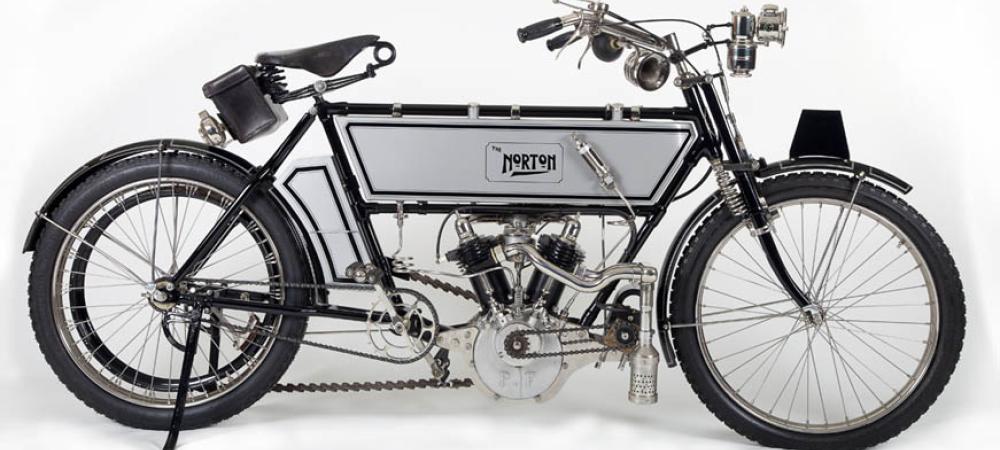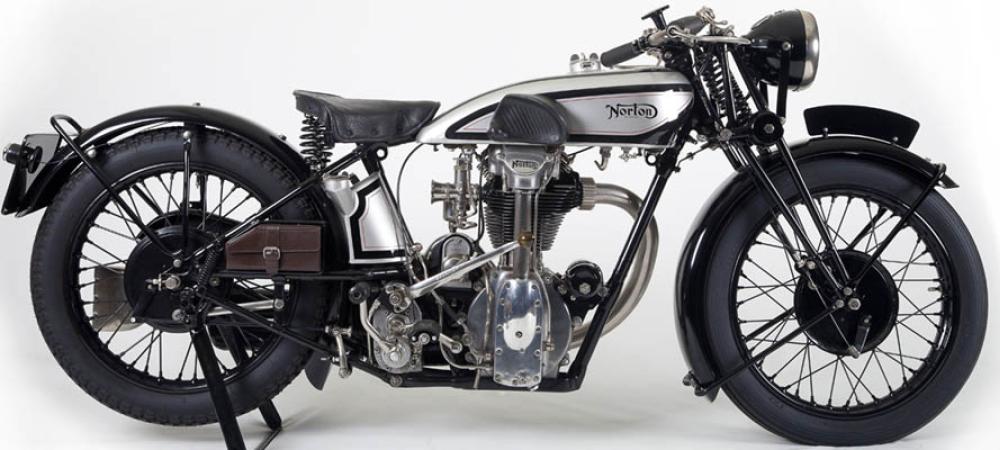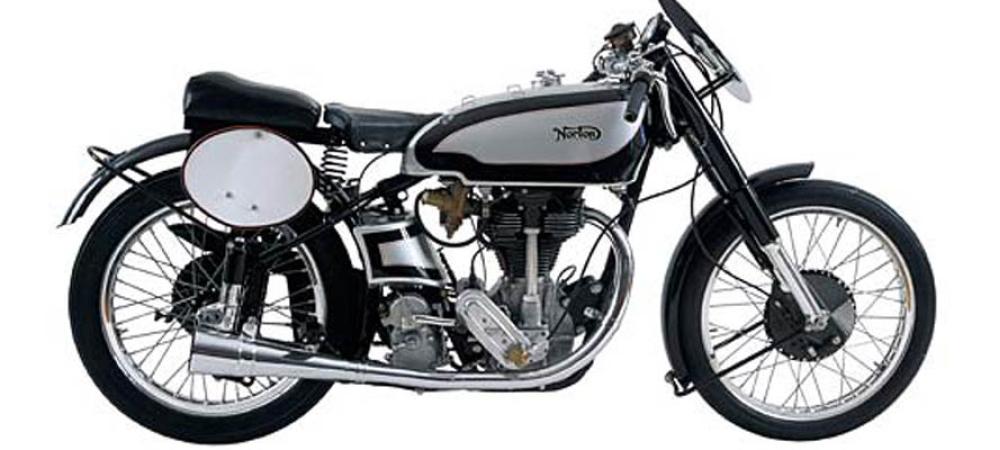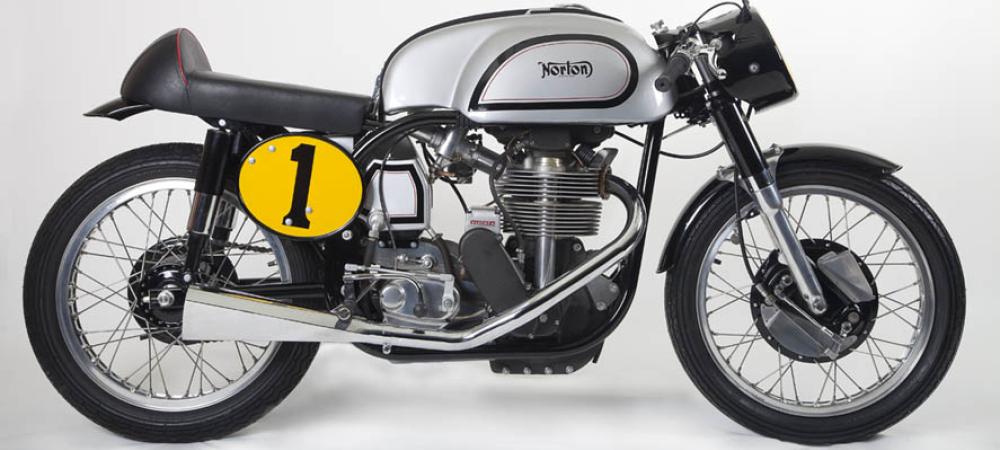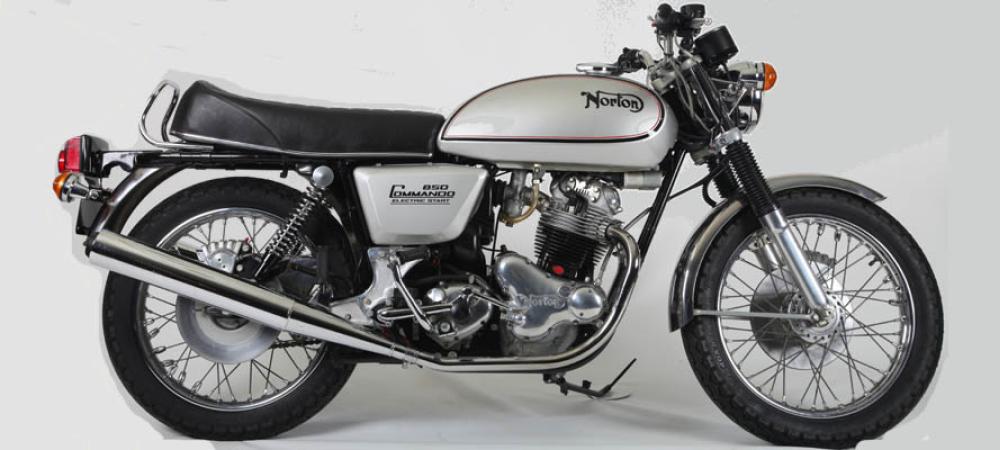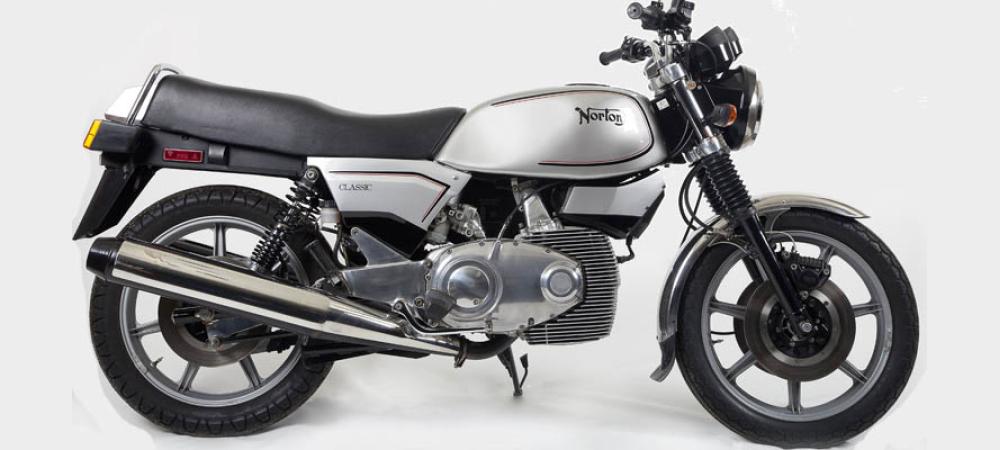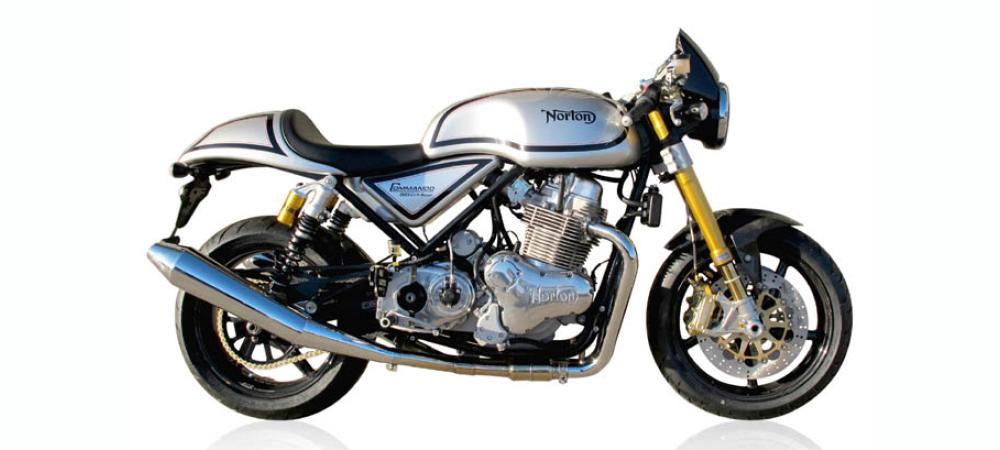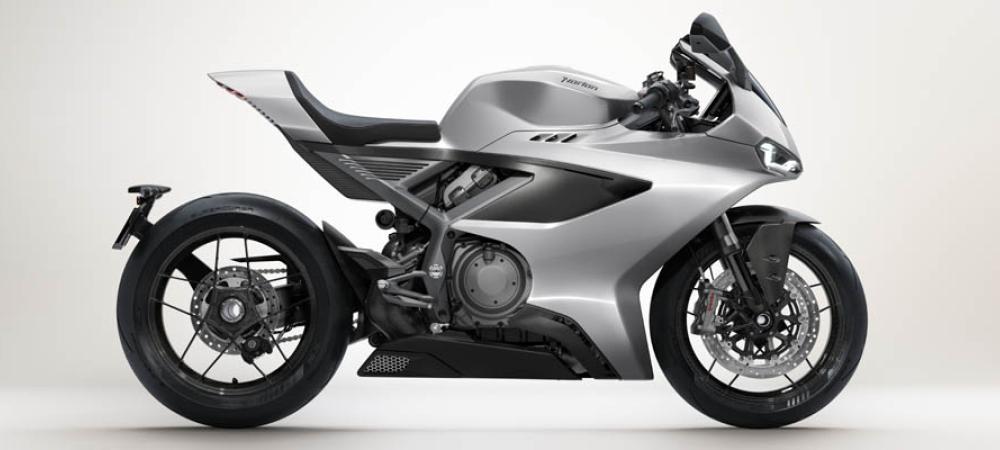THE NORTON INTERPOL 1969 to 1976
The Interpol was a Commando based police bike, developed from an idea that may have been killed off at the boardroom stage. Its critics said that production would be a drain on resources and could hit export capacity, but others saw it as a low-profit, high profile product that was good for the company image.
In 1969, Chairman Dennis Poore recruited Neale Shilton to create and promote a police specification vehicle, based on the Commando. Norton had never been a major player in the police market, although a police specification Atlas had been made. The potential was there to develop some steady sales, at home and abroad, mainly at the expense of Triumph, where much brand-loyalty had been built-up, particularly in the heavyweight market. In those pre-EC days, UK Home Office policy was to buy British and at the time foreign competition in this specialist market was negligible.
Neale Shilton had been the police fleet sales manager for Triumph for a number of years before, but he left them some time before he was recruited by Norton. He brought with him a wealth of knowledge of the market, but in particular he had the right contacts in the police forces, which made him a valuable asset.
Early Examples
The public were able to see the machine launched as the Interpol on display at the 1969 Brighton Bike Show. The display machine carried an Avon fairing with blue light in the screen, Craven panniers and Craven top box on a special rear carrier. These features were in common with Triumphs and other police machines of the time. Headlight brackets were omitted as switches and speedometer were fitted to a flat plate across the fork tops, directly replacing the instrument pods. Mudguards, side panels, tail light bracket and tank were in white. Norton supplied the single seat and special tank with recess for the radio. The show model carried a tank mounted Cossor radio with control unit on top.
The new tank had a familiar look, being derived from the Atlas police version with the radio recess. The base was redesigned to fit over the spine tube and incorporated triangular recesses to clear the top engine mounting plates. The chrome name plate was replaced with the familiar stick-on Norton decal. Knee grips were fitted, Triumph fashion, on this machine, but were later dropped.
The show model retained the low rise handlebars, the deep, black, steel rear chain-guard, and the enclosed rear shock-absorbers of the existing range. The exhaust was also early Commando, as it provided enough clearance for panniers and access to the rear wheel, which was still of the three sleeve nut type, as on the Atlas. The side panels were the long fibreglass ones, as used on some of the Fastback models.
As might have been expected, the prototype was a low budget affair. Neale Shilton took the machine around the country’s police forces, in search of business. He had a product that was ideally suited to police work, and the orders started to come in, but production was delayed until 1970 due to various obstructions and restrictions being placed on its development work.
In production, Norton confined themselves to producing the basic machine, as displayed, with only minor variations. Fairings, panniers and other items were usually fitted off site. The resultant look of the vehicle is as much a product of the factory as it is of the specialist vehicle fitters with the customers requirements being further refined in their own workshops.
The 1971 range improvements included a new main wiring harness, providing an ignition warning light and optional turn indicators. Most of the police specific wiring was now included as standard. This simplified the fitting of Lucas 9H two-tone horns (on the coil brackets), the Lucas HC3 electronic horn control unit and 6RA relays, plus the blue light flasher unit. The latter items were bolted to the left-hand side panel, resulting in the familiar series of screw heads being visible. These extra parts were listed in the spares book, but not the blue lamp, which they state as being part of the fairing and not supplied by Norton, possibly allowing for customer options in the choice of fairing. Twin 6-volt batteries were optional, but with modern radios requiring less current than their valved predecessors, and advances in battery technology, this option may not have been so worthwhile.
A 1971 demonstration machine was shown with front turn indicators fitted to its Avon fairing, but the rear ones await fitting to either stems or panniers. Fork gaiters continued to be used for the 1971 Interpol, having been dropped from the rest of the range in December 1970. The Atlas style tank continued, but now minus knee grips. In fact, the Atlas style tank (minus radio recess) became incorporated into the main product range on the Fastback LR, so displacing the style with the seat extensions around the tank. At 3.5 gallons plus 0.5 gallons reserve, this was a larger capacity tank for the Fastback and was of steel construction in preparation for changes in tank construction legislation.
Police work could push the brakes to their limits and beyond, and Norton’s otherwise excellent twin leading shoe front brake could be inadequate. Disc brakes were developed and became an option in 1971, with conversion kits being made available from the end of the year. Changing to a disc brake required new handlebars, due to the space requirements of the master cylinder. All the disc braked models had higher rise handlebars to accommodate this, but the Interpol had its own variant (part no. 06-2306), which gave sufficient clearance between the control levers and fairing and suited the police style of riding, and continued to be fitted on the 850cc models. Good as they were, faults with the new brakes were still causing problems. The end of 1971 also saw the introduction of the rubber cush rear wheel, although it took a little while to appear in some fleets.
The Interpol was to benefit from the 1972 model changes. The disc brake option was extended to the Mk. IV Fastback and Roadster, and they came with indicators and the revised upswept exhaust system with the reverse-cone silencers. The Combat engine was introduced as more powerful option, and the Interstate changed to a large 5 gallon tank with a new low-level exhaust system. All or any of these could be incorporated on a 1972 Interpol, but choosing upswept exhausts limited the use of panniers. Meanwhile, the police were reviewing their needs, expecting the rider to carry more equipment to do the job and the fiberglass moulders were looking at ways of meeting these new challenges.
Fairing Matters
Up until now, the only option for the fairing seems to have been the Avon item. Subsequently, Norton designed their own fairing, and named it the ‘Northway’, a name perhaps reflecting the company’s Andover address. The fairing was not specifically for police use, as it was listed as an optional extra for other models. The design closely followed that of the Avon and was in fact made for Norton by the same company, Composite Laminated Products (CLP). The main difference is over the headlight, where the Avon has a small peak, extending back on both sides and continuing its line under the screen and down the sides. The Northway has no peak, but the curve of the ‘nose’ from the headlight meets a broader, almost flat section at the front centre near to the base of the screen. Underneath the flat section, there is a small recess to fit the nut at the base of the blue light. The screens differ too. The Avon screen (the SC12) is slightly shorter, made in a single curve, uses ten mounting holes and could be supplied with an aperture for a blue light. The Northway screen is slightly taller and slightly bell shaped at the bottom due to its lower flared curve. It uses nine mounting holes for the 2BA countersunk screws. The screens are not interchangeable. Early versions of either fairing fitted with turn indicators had to have holes cut out to fit them. Later mouldings incorporated a suitable mounting.
Exhaust Systems
The first Interpols used the early standard exhaust system. 1971 saw the forthcoming revisions for the 1972 model Fastback and Roadster, which included an upswept exhaust system with new reverse cone silencers. The Interpol was fitted with the new silencers and a unique set of pipes to permit use of the new silencers in a low-level configuration. This arrangement allowed the bike to be fitted with a standard pannier layout. Unfortunately, the silencers obstructed the rear wheel spindle and their proximity to the swinging arm called for fitting by studs and nuts rather than the usual bolts. Later in 1972, the Interstate gained a low-level exhaust system with its new ‘short and long megaphone’ silencers. This system became standard on the Interpol and continued through to the 850 cc model of 1974, when the ‘black-cap’ silencers system appeared. The Interpol followed suit.
Insomniacs Exhaust Note
The unique pipes for 1971/72 had part numbers 06 2545 (left) and 06 2546 (right) but are no longer listed. They look similar to the early Interstate types but in the case of the Interpol, the second bend is slightly further forward, and higher, with a lower output angle. Some pipes are angled slightly further inwards, towards the frame tubes, due to a mitre in the pipe near the exhaust port, like the 1969 Fastback. It is not possible to directly fit reverse-cone silencers on to low-level Interstate pipes.
Tanks And Mudguards
When the standard fitting for the tyres increased to 410 x 19, for Dunlop TT100s, a wider front mudguard was introduced. Similarly, a deeper valanced front mudguard was also available. Some early mudguards have been found to be chrome underneath. Several styles of tank were available to suit the radio installation. The older Atlas style was available plain, with a radio recess, with tapped inserts, or with pommels (the same as used to take the rear rubber band holding down the back of the tank.) The newer 5 gallon Interstate tank gave an excellent range, but no radio mounts. Being longer, it was used with a revised single seat.
Mounting A Radio
Radio equipment was starting to migrate from the tank to the rear of the machine. This made for better weight distribution, but more importantly, was safer for the rider in a collision. The absence of radio gear in the tank greatly reduced the injuries sustained in an accident. Headsets in the helmets and press-to-talk switches on the handlebars were appearing. Lancashire Constabulary pioneered these techniques, and their Interpol’s were the first with radio-free tanks.
The cost of a radio was almost the same as a bike, so radios had to serve on several machines before they were unserviceable. Radio manufacturers produced a range of mounting hardware to suit most variations. Many older sets would be rendered obsolete by being 6 volts only. The Cossor set as seen on the 1969 show machine was obsolescent. Although popular in the mid-1960s and it could work on 6 or 12 volts, it was heavy, bulky and did not meet emerging communications needs.
The commonest radio was probably the Pye Westminster. Introduced in 1967 in car dash-mount form, remote boot mount and motorcycle versions soon appeared. It was smaller and lighter than its predecessors, offered more facilities, more channels, had a range of universal mounts, could work on positive or negative earth systems and 6 or 12 volts DC. The last ones were removed from police service in 1985, long after the Interpol’s went. The drab-green military version was called the Pegasus.
Softly, Softly
Sometimes the Interpol would be used in the same way as an unmarked police car. Typically unfaired in black or dark blue paintwork, perhaps with matching black panniers which could accommodate a radio, it would not look conspicuous on the road. If required, the alloy band around one of the panniers could be cut to the right length to make a discrete aerial for the radio. As an alternative, on a machine with a fairing, a thin aerial wire could be placed down the centre of the screen to avoid detection. A discrete switch could be fixed to the handlebars to allow a press-to-talk transmitting facility, and an audio cable would lead from a quick-break connector between the seat and tank, with the rest of the wiring beneath the riders clothing.
Moulding The Changes
Around the 1972-73 era, design changes were beginning to appear in the fiberglass extras that have such a marked effect on the look of the standard bike. A set of panniers were produced that were more curvaceous, in keeping with the Interstate tank. Similarly, another design of fairing was produced that was rather angular, being relatively flat across the front and slab sided. It was quite common for a metal or fibreglass illuminated ‘POLICE - STOP’ sign to be mounted at the back of the machine. This period introduced a new design of fibreglass moulded sign, resembling the base of a pyramid. Two triangular shaped plates held the sign to the radio carrier plate. It complemented the existing types. Also, by now, rear mounted flashing blue lights were beginning to appear.
Two-tone air horns became available, and were often mounted with the compressor in or on one pannier (or on its tie-bar from the rear footrest) with the horns on the other. Similarly, horns could be on the fairing with the compressor inside. They were usually made by Fiamm, and the compressor was a variant of the type used on musical car horns. Fire extinguishers were often fitted. The Chubb BCF type with a green torpedo type body and black cap were quite common. Normally they were fitted on the panniers, but due to theft and vandalism, it was not uncommon to fit them in the panniers.
These design changes, combined with factory changes for the new 850cc machines of 1973 and the revisions of 1974, produced a more pleasing, integrated overall effect and fitness for purpose. The design and fit of all the bolt-on bits had come together. The bulk of the bike was standard except for seat and paintwork, but options on gaiters and mudguards continued. No more special tanks, exhausts or handlebars, but a special it remained.
New Counties, New Channels
In 1974, the UK County boundary changes meant re-arrangements to the corresponding police force boundaries. Many machines still covered the same ‘patch’, but were now part of a different police authority, each of which was setting new standards of uniformity and often required a change of radio and associated equipment. In upgrading the radio equipment, many authorities decided to standardise on the same equipment as used in patrol cars. The usual choice was the Pye Whitehall, a member of the Westminster family (from 1971) mentioned earlier. Not being available ruggedised, use on a bike meant some form of housing was essential if radio equipment was to survive. The fitting of radio boxes meant that the ‘POLICE-STOP’ sign was relocated or changed, but blue lights, two-tone horns and even fire extinguishers were often moved or changed. These changes, coupled with new or redesigned traffic stripes changed the bike's appearance considerably but the machine was mechanically the same.
Radio In A Box
There was nothing new in putting a radio in a box, but now the box needed to be longer and wider than earlier designs, with somewhere for the control unit. The first boxes were a rather crude affair, basically two simple boxes made of flat fiberglass sheets with sloping front panels to gain access to the equipment. A later design was produced by Screenflow Plastics of Bolton. It consisted of a tray-like base with overlapping lid, hinged at the rear, and over-centre catches on each side towards the front. The lid started with a gentle upward curve at the front, rising a few inches to a square plateau at the back, giving it a distinctive hump which accommodated the control unit underneath. The lid also incorporated a metal plate with suitable hole to cater for the aerial arrangements. Boxes were usually mounted to the radio plate, buffered with rubber mountings as used on the silencers. Sometimes, the police sign was directly mounted to the rear of the lid as the extra length of the box extended beyond the mounts for the sign. The Screenflow box continued in use on later Triumphs, and on BMWs until high speed handling problems arose. BMW attributed this to the aerodynamic shape of the box, but the problem did not seem to arise on the Norton.
More Fairings
Before the Interpol ended its production run in 1976, at least another two fairing designs had appeared. One of these was also believed to have been called ‘Northway’, reverting to its original curvaceous Avon shape, but with the addition of blue lights in the front leg-shield section, and a raised fibreglass section taking up the bottom half of the screen area. The screen was now smaller, but stayed at the same height, and was made of polycarbonate instead of Perspex (or Oroglass). The second was by CLP, the makers of Avon fairings. This had a scalloped appearance across the headlight area and featured bolt-on lower panels. Later versions of this were finished in black inside, and had lockable glove-box lids. The same basic fairing, but with changed lower panels, was also used on the later Triumphs and pre-RT BMWs.
Miscellany
Unlike police patrol cars, running three shifts a day with an assortment of drivers, the bikes are allocated to one rider and his duty pattern. The riders are highly trained motorcyclists, often a biker anyway, with the bike being one of the tools of the trade. He (or she) needs to ensure that the machine is correctly serviced, maintained and adjusted to suit them, as their life could depend on it. As a result, it is not unusual for machines to have only two or three regular riders while in police service, and to be ‘retired’ after four or five years with only thirty to forty thousand miles on the clock. This did not stop them being thrashed or bashed, or covering a high mileage, but they were repaired and maintained accordingly. The only drawback to all this regular cleaning and polishing seems to come from the use of de-greasing fluid and pressure hoses. This forced water behind the nuts and locking washers on the engine and found its way into the Isolastics, causing bolts, studs and shims to corrode and seize.
No doubt, some machines will have been modified to suit a specific need, but generally, this seems to be no more than a change of gearbox sprocket with an extra tooth. However, some police forces took precautions to prevent the grounding of the left-hand levers by removing the side stand or by fitting a small bracket to stop the rear brake lever falling down, should the cable break. The centre stand, always a weak point, may also have been strengthened. Most riders had some influence over what was done for their safety and convenience.
All the usual Commando faults (and more) would appear, but sooner and more often. This has to be considered against the number of machines made, their mileage and the period in service, but big boots and enthusiastic riding didn’t help. In one infamous incident, a batch of twenty-five Interpols, exports to Kuwait, ended up being ditched in the Arabian Gulf because their overheating and reliability problems could not be resolved. However, it all aided development for others as these problems were not just limited to police riders or machines and, in time, have largely been overcome.
The Final Form
Various changes in the other Commando models were reflected in the Interpol, including the change from right to left hand gear change, an electric starter and adjustable Isolastic mounts. By September 1975 the final form was reached and no more development done. Almost the longest running Commando model, it was discontinued in 1976. Its creation had been justified. A financial drain had turned into a financial lifeline and into its own chapter of Norton history.
By now police BMWs (and others) were appearing, equipped in the same style as the Interpol. Hardly surprisingly really, as Neale Shilton was employing his talents on Bavarian Boxers. It was in 1977 before money became available to fund development of a new rotary engined machine which emerged a few years later as the Interpol ll.
In its time, the Interpol was exported and saw service with the Police in such unlikely places as France, Kuwait and Nigeria. It was also bought by the British Army. Exact production figures are unknown, due to poor record keeping in later years. However, in the twelve months from April 1972, a total of 250 Interpols were made.
A Life In Retirement
All ex-police bikes have carried a certain stigma with bikers, a fact reflected in their second-hand value. Some were turned into specials and others broken for spares, but many were civilianised. Nearly all surviving Interpols will have lost all trace of their origins as no special engine or frame markings were used. Therefore most survivors look like, and are accepted as, any other civilian machine. Very few examples (perhaps as few as 4 or 5) remain in standard Interpol form, if indeed, a standard ever existed.
© Gerry Scott
Originally published in the Norton Owners Club Classic Calendar for 1999

